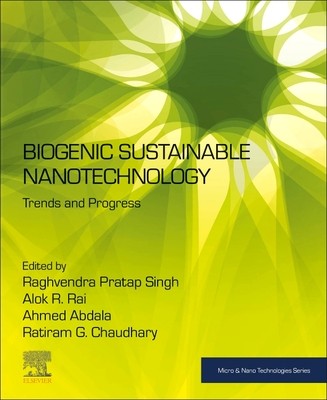
- We will send in 10–14 business days.
- Publisher: Elsevier
- ISBN-10: 0323885357
- ISBN-13: 9780323885355
- Format: 19.1 x 23.5 x 2.2 cm, softcover
- Language: English
- SAVE -10% with code: EXTRA
Biogenic Sustainable Nanotechnology (e-book) (used book) | bookbook.eu
Reviews
Description
Biogenic Sustainable Nanotechnology: Trends and Progress focuses on the green synthesis of nanomaterials with various biological systems, emphasizing the mechanisms of nanomaterial synthesis, spectroscopic characterizations, and applications in a variety of industrial sectors.
Interest in developing eco-friendly, green, cost-effective, and facile methods for nanomaterials synthesis is rapidly growing. Green synthesis methods focus on a greener environment, minimizing generated waste, and implementing sustainable processes. As discussed in this book, green nanostructured materials often include phytochemical agent extracts, such as carbohydrates, flavonoids, saponins, proteins, amino acids, chromone, steroids, phytol, and terpenoids. These phytochemicals from plant extracts play a crucial role in improving the reduction rate, size, and stabilization, by acting as good reducers, surfactants, structure directors, and capping agents.
This book is an essential reference source for materials scientists, bioengineers, and environmental scientists.
EXTRA 10 % discount with code: EXTRA
The promotion ends in 14d.10:11:11
The discount code is valid when purchasing from 10 €. Discounts do not stack.
- Publisher: Elsevier
- ISBN-10: 0323885357
- ISBN-13: 9780323885355
- Format: 19.1 x 23.5 x 2.2 cm, softcover
- Language: English English
Biogenic Sustainable Nanotechnology: Trends and Progress focuses on the green synthesis of nanomaterials with various biological systems, emphasizing the mechanisms of nanomaterial synthesis, spectroscopic characterizations, and applications in a variety of industrial sectors.
Interest in developing eco-friendly, green, cost-effective, and facile methods for nanomaterials synthesis is rapidly growing. Green synthesis methods focus on a greener environment, minimizing generated waste, and implementing sustainable processes. As discussed in this book, green nanostructured materials often include phytochemical agent extracts, such as carbohydrates, flavonoids, saponins, proteins, amino acids, chromone, steroids, phytol, and terpenoids. These phytochemicals from plant extracts play a crucial role in improving the reduction rate, size, and stabilization, by acting as good reducers, surfactants, structure directors, and capping agents.
This book is an essential reference source for materials scientists, bioengineers, and environmental scientists.


Reviews